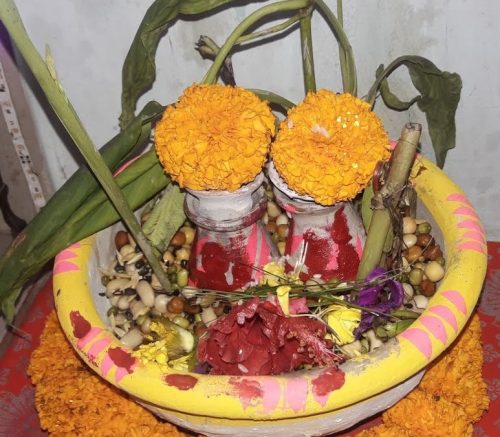Many of us might recall from our childhood how our mothers, aunts and grandmothers would read aloud the Itu Pujo broto katha (mythological stories in Bengali on different rituals) of the two sisters Umno and Jhumno. And their ordeal after they were sent to a jungle by their angry father because they ate his share of Pitheys (rice cakes). To get back home, the two sisters Umno and Jhumno performed the Itu Pujo as taught by them by the other worshippers in a village near the jungle.
It’s the last Sunday or the last day of Agrahayan (Bengali month falling between November and December) when the womenfolk perform the Itu Pujo in Bengali households. The ritual perfectly intermingles with the mild winter and the heavenly smell of the Payesh (a type of rice pudding sans the egg) of newly harvested jaggery and Gobindobhog Atop rice (perfumed short grain rice locally grown in Bengal) from the kitchens.

The Itu Pujo is a unique Bengali ritual, along with different Shosthis and Bhaiphota, which does not need a Brahmin priest to perform. Instead, the Bengali women, primarily married women, take the initiative to carry the annual Itu Pujo in their respective households. Though the women performs the Itu Pujo ritual, the mantras or the recited hymns ask about Itu’s blessing for their fathers’ and their brothers’ prosperity signifying the prevalence of patriarchy since the old times.
The other thing that this ritual is quintessentially connected with is its famous prasad (offering), Nabanna- prepared with new fruits and newly harvested ingredients. Before exploring Nabanna, let us understand the essential Itu Pujo ritual and its meaning.
Itu Pujo Ritual:
The word ‘Itu’ comes from ‘Mitu’ or ‘Mitra’, meaning Sun. The Bengali womenfolk worship Itu as the goddess of fertility, representing an incarnation of the Sun. A ritualistic ‘Ghot’ or Pot is placed in an auspicious corner of the house along with different herbs and leafy vegetables like Water Spinach, Mustard greens, and other grain seeds like sesame, barley, paddy etc.
Itu Pujo heralds the time for the harvest of a few crops and the time when short-term crops are sown which would be harvested during Spring or Makar Sankranti. Bengal is endowed with the natural gifts of fertile land and rivers, which results in quite a few sowing and harvesting seasons in a year. Itu Pujo is one ritual where nature is thanked for its natural resources.
The Itu Pujo was initially meant for the preservation of the seeds of the winter crops that would be harvested in the month of Poush (December-January). Before the Pujo starts, an earth-filled bowl and a pot of water is kept along with other household god idols. Earth and Water, both stands important for the cultivation activity.
If we take a look on the Itu Pujo mantras, we can find how almost all the prayers are asking for bountiful agricultural crops and prosperous home.
Itu Pujo Mantra:
“Oshto Chaal, Oshto Durba, Kalashpatra Thuye
Itur Katha shobey pran ekmon hoye
Itu den bor
Dhono-dhanye putre-poutre baruk sansar………….”
(We place 8 grains of rice, 8 grass strands on the auspicious water pot and listen about the Itu Goddess. Itu blesses us with a promise of prosperous family.)
Preparation of Nabanna Prasad
Nabanna is a food prepared as the principal offering on the last Sunday of the Itu Pujo. First, the newly harvested Gobindobhog Atop rice is soaked for some time and then grounded coarsely. The pasted rice is then mixed with milk which serves as the base. Next, Notun gur or freshly harvested date palm jaggery is added as a sweetener to the base. Later, all the available fruits like apples, bananas, sugarcane, orange, pear and other dry fruits are chopped and mixed with the rice-milk-jaggery base to be served as Nabanna.

The above preparation details were shared to us by Rakhi Roy Basu, Parna’s sister-in-law. Itu Pujo was performed in her ancestral maternal home during her childhood. As she shared about the Nabanna preparation, she could vividly describe the same taste from her childhood. She described the beautiful aroma of the freshly pounded rice blending well with that of the cut fruits and the new date palm jaggery filling their senses before it fulfilled their appetites.
Significance of Itu Pujo in the Bengali culture
If Saraswati Pujo ushers in the Spring for us Bengalis, Itu Pujo welcomes the winter. Though the latter is not as famous as the former one, it celebrates the nip in the air, the tastes and smells that define the winter of the Bengali countryside which culminates with the Poush Sankranti’s Pithey Parbon. As the days go by, the ritual might also get drowned in the sands of time, but, the celebration of the advent of winter with Nabanna seasoned with Notun gur will keep continuing in some forgotten corners of a few Bengal villages.
(Recommended Read: Joydev Kendulir Mela – The fair that celebrates humanity and music)

